numos
Hazard to Others
  
Posts: 270
Registered: 22-2-2014
Location: Pasadena
Member Is Offline
Mood: No Mood
|
|
Interhalogens
So, with the help of my newly built fume hood, I had a go at making two interhalogens.
Iodine monobromide is very straight forward, I just added Bromine to Iodine in a RBF and I heated that in a water bath to around 45oC.
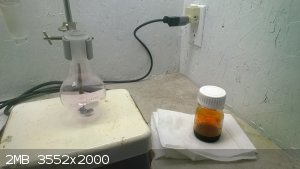 (Bromine not yet added) (Bromine not yet added)
I used an excess of iodine in hopes of being able to melt the Iodine monobromide and separate it from the remaining iodine that way. That didn't
really work so in the future an excess of bromine may be wiser.
Iodine trichloride was a terrible experience, liquid chlorine is just a very difficult substance to work with, but it was quite exciting to work so
closely with it, and I look forward to doing more with it. The first step was to make some liquid chlorine itself, which using dry ice, was easier
than I expected. I made a total of ~2ml.
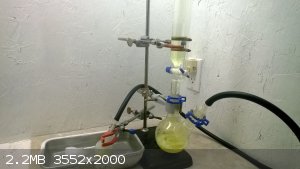 Simple chlorine generate with glass pipette leading into pear flask Simple chlorine generate with glass pipette leading into pear flask
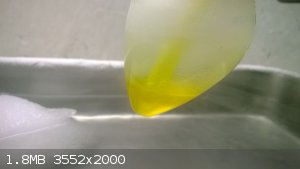
While keeping it cold I added ~0.2 grams iodine and stirred. After about 10 minutes it had gone opaque and I could a fine suspension of yellow powder.
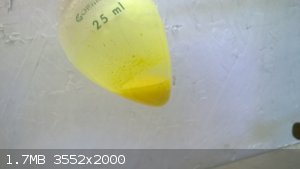
Once all the iodine had reacted away I took it out of the ice and put it outside, allowing the remaining chlorine to boil away. This left me with an
orange power.
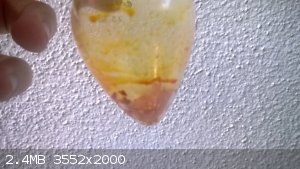
A problem I had with both of these is that they stick to water like nothing, even a day in the vacuum desiccator had no effect. Wet like they are here
makes them kind of useless for reactions, however just as a sample, they will do fine for me.
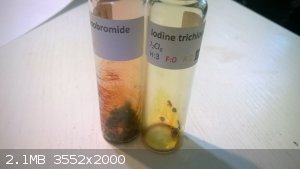
Any suggestions for drying them would be most welcome, I couldn't find a formal procedure for either of these, and I had to experiment around a
little. If anyone wants to try this, make sure to condense the chlorine in the container you wish to experiment with, because transferring with a
pipette is basically impossible, and pouring it seemed like a bad idea. Also, the Bromine - Iodine reaction does generate some heat initially, so
watch out for boiling if you add it too fast.
If anyone has tried something similar I'd love to hear your experience, if there is a better way to go about this.
Edit: deleted unnecessary stuff
[Edited on 6-14-2015 by numos]
|
|
|
DraconicAcid
International Hazard
    
Posts: 4412
Registered: 1-2-2013
Location: The tiniest college campus ever....
Member Is Offline
Mood: Semi-victorious.
|
|
I made IBr as an undergraduate, and we sublimed it to purify it. We also reacted it with pyridine to make the ionic [I(py)2]Br, which was interesting
but smelly. I think we did that in chloroform, and recrystallized it by heating it up to dissolve, then slow cooling.
Please remember: "Filtrate" is not a verb.
Write up your lab reports the way your instructor wants them, not the way your ex-instructor wants them.
|
|
|
woelen
Super Administrator
        
Posts: 8080
Registered: 20-8-2005
Location: Netherlands
Member Is Offline
Mood: interested
|
|
IBr and ICl3 react with water. They hydrolyze and at the same time an autoredox reaction occurs:
5 IBr + 3 H2O <---> HIO3 + 5 HBr + 2 I2
5 ICl3 + 9 H2O <---> 3 HIO3 + 15 HCl + I2
The ICl3 which you have looks orange/brown. Pure ICl3 is pale yellow. The brown color is due to reaction with water in which I2 is formed (see
equation above).
|
|
|
AJKOER
Radically Dubious
    
Posts: 3026
Registered: 7-5-2011
Member Is Offline
Mood: No Mood
|
|
Here are some comments per Wikipedia on Iodine monochloride (link: https://en.m.wikipedia.org/wiki/Iodine_monochloride#Polymorp... ), an interhalogen compound with the formula ICl, described as a red-brown
compound that melts near room temperature. To quote on its preparation:
"Iodine monochloride is produced simply by combining the halogens in a 1:1 molar ratio, according to the equation
I2 + Cl2 → 2 ICl
When chlorine gas is passed through iodine crystals, one observes the brown vapor of iodine monochloride. Dark brown iodine monochloride liquid is
collected. Excess chlorine converts iodine monochloride into iodine trichloride in a reversible reaction:
ICl + Cl2 = ICl3"
as apparently, ICl + Cl2 is in equilibrium with ICl3.
Wikipedia on ICl3, https://en.m.wikipedia.org/wiki/Iodine_trichloride , to quote:
"Iodine trichloride is an interhalogen compound of iodine and chlorine. It is bright yellow and in the solid state is present as a planar dimer I2Cl6,
Cl2I(μ-Cl)2ICl2, with two bridging Cl atoms.[1]
It can be prepared by reacting iodine with an excess of liquid chlorine at −70 °C. In the melt it is conductive, which may indicate
dissociation:[2]
I2Cl6 is in equilibrium with ICl2+ + ICl4−
Iodine trichloride can be created by heating a mixture of liquid iodine and chlorine gas to 105 °C."
Not certain on accuracy here and I was able to find another more detail account, see http://pubs.acs.org/doi/abs/10.1021/ja01352a501#/doi/abs/10....
[Edited on 14-6-2015 by AJKOER]
|
|
|
numos
Hazard to Others
  
Posts: 270
Registered: 22-2-2014
Location: Pasadena
Member Is Offline
Mood: No Mood
|
|
Quote: Originally posted by DraconicAcid  | | I made IBr as an undergraduate, and we sublimed it to purify it. We also reacted it with pyridine to make the ionic [I(py)2]Br, which was interesting
but smelly. I think we did that in chloroform, and recrystallized it by heating it up to dissolve, then slow cooling. |
I know it's a long shot, but do you remember how you prepared it? I remember the sigma aldrich MSDS said something about storing it under an inert
gas. But technique-wise did you just add Bromine to Iodine?
The current situation also agrees with Woelen's post, I'm looking at the vial now, the Iodine trichloride has no more solid left, it's all been
hydrolyzed, and I'm left with a few drops of dark brown liquid, with a strikingly deep yellow vapor above, which I'm guessing is chlorine? This
confuses me, the hydrolysis reaction forms HCl, so why is there chlorine vapor? Could it be that the reverse of reaction AJKOER posted, "ICl + Cl2 =
ICl3" is happening first and then the ICl is hydrolyzing?
|
|
|
woelen
Super Administrator
        
Posts: 8080
Registered: 20-8-2005
Location: Netherlands
Member Is Offline
Mood: interested
|
|
Both AJKOERS reaction and hydrolysis occur at the same time. The deep yellow color of the vapor is caused by a mix of mainly chlorine, contaminated
with traces of ICl. Although most iodine is present as ICl3, some of it is present as ICl. ICl vapor is dark brown, and when just a tiny amount of
this is mixed with Cl2, then you get a yellow color.
|
|
|
DraconicAcid
International Hazard
    
Posts: 4412
Registered: 1-2-2013
Location: The tiniest college campus ever....
Member Is Offline
Mood: Semi-victorious.
|
|
Quote: Originally posted by numos  | | I know it's a long shot, but do you remember how you prepared it? I remember the sigma aldrich MSDS said something about storing it under an inert
gas. But technique-wise did you just add Bromine to Iodine? |
I think so. We made it twice- once directly, and once in solution (the solution was used to make the pyridine complex).
Please remember: "Filtrate" is not a verb.
Write up your lab reports the way your instructor wants them, not the way your ex-instructor wants them.
|
|
|